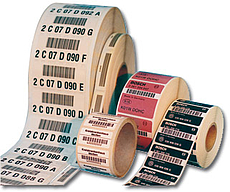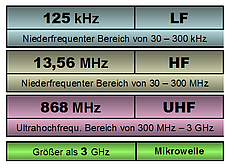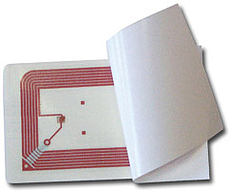RFID License Plates
How RFID works
Radio Frequency IDentification works in a similar way to a radio broadcasting system. The transponder (chip plus antenna) functions as both the transmitter and receiver of the reader (writing and reading device). As a transmitter/receiver unit, the writing and reading device is, however, also responsible for processing new datasets. For the transponder and reader to able to exchange data, they must be operating on the same frequency.
To exchange data, energy must be sent to the transponder's antenna by way of a magnetic field. As long as the transponder is within range of the magnetic field, it is able to exchange and modify data.
Once the reader or transponder is removed from the transmission (induction) area, data exchange is no longer possible. The use of different frequencies and antenna sizes has a great effect on obtaining longer or shorter ranges. Security against counterfeit transponder chips is achieved by using unchangeable number groups. This unique, tamper-free registration number is permanently installed inside every transponder, which it means it is identifiable at all times.
Motor Vehicle Registration System (MVRS)
Why RFID?
Transponders have many advantages compared to barcodes or machine-readable characters:
- Multiple instances of data writing are possible with a transponder.
- A barcode needs to be changed to modify the data. This is not necessary for transponders.
- Barcodes are unreadable if they are soiled, smudged or painted over. This is not a problem with transponders
- Transponders can be read out through stone, wood, plastic and other non-metallic materials. A barcode cannot function without a line of sight.
- A barcode is easy to copy or duplicate, unlike a transponder, whose fixed internal number is virtually impossible to forge.
- A transponder has considerably more storage capacity than a barcode
Transponder makes more sense whereas a barcode has its limitations
Frequencies
The different frequencies in a transponder are used for different frequency ranges and different ambient conditions.
The following frequencies are commonly used throughout Europe and some other parts of the world: 125 kHz, 13.56 MHz and 868 MHz.
Reader/writers and antennas only work with transponders designed for the corresponding frequency ranges. For instance, it is not possible for a 125 kHz reader to read from or write to a 13.56 MHz transponder.
Ranges
Short distances of 1 to 8 cm are achieved with passive 125 kHz transponders (passive) and reading devices. Areas of application are e.g. Door control systems, control points, etc., in which greater range would be a disadvantage. If you had a transponder with a higher range, doors would be unintentionally opened.
With the world's only released frequency of 13.56 MHz, the range is up to 2.5 mtrs depending on the environment and antenna size. These transponders (passive) are particularly suitable for the area of ??logistics, packaging and product recognition and securing. Reading devices and passive transponders can be read out in the pulk (bulk reading) up to about 50 pieces in a packed state at the same time and are equipped with new data. Pollution and humidity hardly affect reading.
The frequency band of 868 MHz is becoming more and more important because of the relatively high range of up to 9 mtrs and the low transponder price.
Contact
We will be pleased to help
Waldemar Ginter
+49 271 39 32 - 0
Contact form
Claudia Müller
+49 271 39 32 - 0
Contact form







